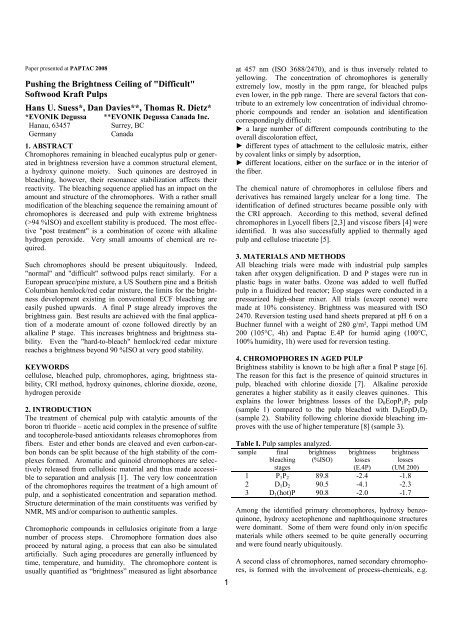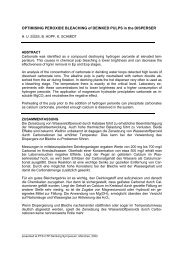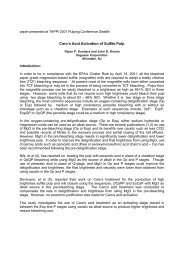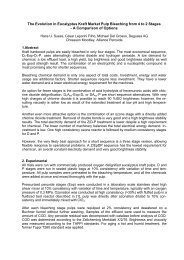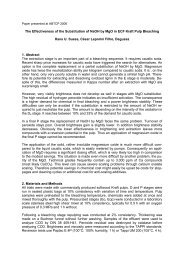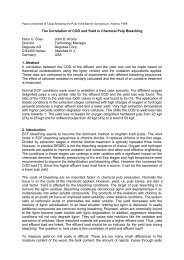PDF (211.74 KB) - Hydrogen Peroxide
PDF (211.74 KB) - Hydrogen Peroxide
PDF (211.74 KB) - Hydrogen Peroxide
Create successful ePaper yourself
Turn your PDF publications into a flip-book with our unique Google optimized e-Paper software.
Paper presented at PAPTAC 2008Pushing the Brightness Ceiling of "Difficult"Softwood Kraft PulpsHans U. Suess*, Dan Davies**, Thomas R. Dietz**EVONIK Degussa **EVONIK Degussa Canada Inc.Hanau, 63457Surrey, BCGermanyCanada1. ABSTRACTChromophores remaining in bleached eucalyptus pulp or generatedin brightness reversion have a common structural element,a hydroxy quinone moiety. Such quinones are destroyed inbleaching, however, their resonance stabilization affects theirreactivity. The bleaching sequence applied has an impact on theamount and structure of the chromophores. With a rather smallmodification of the bleaching sequence the remaining amount ofchromophores is decreased and pulp with extreme brightness(>94 %ISO) and excellent stability is produced. The most effective"post treatment" is a combination of ozone with alkalinehydrogen peroxide. Very small amounts of chemical are required.Such chromophores should be present ubiquitously. Indeed,"normal" and "difficult" softwood pulps react similarly. For aEuropean spruce/pine mixture, a US Southern pine and a BritishColumbian hemlock/red cedar mixture, the limits for the brightnessdevelopment existing in conventional ECF bleaching areeasily pushed upwards. A final P stage already improves thebrightness gain. Best results are achieved with the final applicationof a moderate amount of ozone followed directly by analkaline P stage. This increases brightness and brightness stability.Even the "hard-to-bleach" hemlock/red cedar mixturereaches a brightness beyond 90 %ISO at very good stability.KEYWORDScellulose, bleached pulp, chromophores, aging, brightness stability,CRI method, hydroxy quinones, chlorine dioxide, ozone,hydrogen peroxide2. INTRODUCTIONThe treatment of chemical pulp with catalytic amounts of theboron tri fluoride – acetic acid complex in the presence of sulfiteand tocopherole-based antioxidants releases chromophores fromfibers. Ester and ether bonds are cleaved and even carbon-carbonbonds can be split because of the high stability of the complexesformed. Aromatic and quinoid chromophores are selectivelyreleased from cellulosic material and thus made accessibleto separation and analysis [1]. The very low concentrationof the chromophores requires the treatment of a high amount ofpulp, and a sophisticated concentration and separation method.Structure determination of the main constituents was verified byNMR, MS and/or comparison to authentic samples.Chromophoric compounds in cellulosics originate from a largenumber of process steps. Chromophore formation does alsoproceed by natural aging, a process that can also be simulatedartificially. Such aging procedures are generally influenced bytime, temperature, and humidity. The chromophore content isusually quantified as “brightness” measured as light absorbance1at 457 nm (ISO 3688/2470), and is thus inversely related toyellowing. The concentration of chromophores is generallyextremely low, mostly in the ppm range, for bleached pulpseven lower, in the ppb range. There are several factors that contributeto an extremely low concentration of individual chromophoriccompounds and render an isolation and identificationcorrespondingly difficult:► a large number of different compounds contributing to theoverall discoloration effect,► different types of attachment to the cellulosic matrix, eitherby covalent links or simply by adsorption,► different locations, either on the surface or in the interior ofthe fiber.The chemical nature of chromophores in cellulose fibers andderivatives has remained largely unclear for a long time. Theidentification of defined structures became possible only withthe CRI approach. According to this method, several definedchromophores in Lyocell fibers [2,3] and viscose fibers [4] wereidentified. It was also successfully applied to thermally agedpulp and cellulose triacetate [5].3. MATERIALS AND METHODSAll bleaching trials were made with industrial pulp samplestaken after oxygen delignification. D and P stages were run inplastic bags in water baths. Ozone was added to well fluffedpulp in a fluidized bed reactor; Eop stages were conducted in apressurized high-shear mixer. All trials (except ozone) weremade at 10% consistency. Brightness was measured with ISO2470. Reversion testing used hand sheets prepared at pH 6 on aBuchner funnel with a weight of 280 g/m², Tappi method UM200 (105°C, 4h) and Paptac E.4P for humid aging (100°C,100% humidity, 1h) were used for reversion testing.4. CHROMOPHORES IN AGED PULPBrightness stability is known to be high after a final P stage [6].The reason for this fact is the presence of quinoid structures inpulp, bleached with chlorine dioxide [7]. Alkaline peroxidegenerates a higher stability as it easily cleaves quinones. Thisexplains the lower brightness losses of the D 0 EopP 1 P 2 pulp(sample 1) compared to the pulp bleached with D 0 EopD 1 D 2(sample 2). Stability following chlorine dioxide bleaching improveswith the use of higher temperature [8] (sample 3).Table I. Pulp samples analyzed.sample finalbleachingstagesbrightness(%ISO)brightnesslosses(E.4P)brightnesslosses(UM 200)1 P 1 P 2 89.8 -2.4 -1.82 D 1 D 2 90.5 -4.1 -2.33 D 1 (hot)P 90.8 -2.0 -1.7Among the identified primary chromophores, hydroxy benzoquinone,hydroxy acetophenone and naphthoquinone structureswere dominant. Some of them were found only in/on specificmaterials while others seemed to be quite generally occurringand were found nearly ubiquitously.A second class of chromophores, named secondary chromophores,is formed with the involvement of process-chemicals, e.g.
not determined, see Figure 5. Once more a considerable stabilizationof the structure results by superposition of the twotautomers under acidic conditions and by strong resonance stabilizationin neutral and alkaline media. Similar hydroxyl-[1,4]benzoquinone and hydroxyl-[1,4]naphthoquinone moietieshave been found as chromophores in a wide range of other cellulosicproducts. This is reasonable since these primary chromophoresare generated from low-molecular weight carbohydrates(cellulosic and hemicellulosic degradation products) bydegradation / condensation in general, and are thus independentof the specific pulp source.HHO OO OOOOH5OOOOOOHOOOacidic mediumneutral andalkaline mediumO OFig. 5: Stabilization of 5-hydroxy-[1,4]naphthoquinone structures,by means of the example 5,8-dihydroxy-[1,4]naphthoquinone(5), cf. also Figure 4.2-Hydroxy-[1,4]benzoquinones are sensitive toward electrophilicattack in 3-position (cf. the carbanionic resonance structurein Figure 6), which rationalizes the introduction of chlorineinto this position in the presence of Cl + or hypochlorite, as in achlorine dioxide bleaching stage. This mechanism is responsiblefor the formation of 6 and 7 from 1. As a result of their peculiarstructure, they can also be attacked nucleophilically at 3-position, which corresponds to a Michael addition to α,β-unsaturatedcarbonyl moieties. The resulting cyclohexenediones arevery easily – immediately upon contact to air - re-oxidized tothe 3-substituted 1,4-benzoquinoid system, see Figure 6. Thefact that 2-hydroxy-[1,4]benzoquinones can be attacked bothnucleophilically and electrophilically accounts also for theirtendency to undergo self-condensation.In summary, the 2-hydroxy-[1,4]benzoquinone moieties show apeculiar reactivity, which can be characterized by three features:1) resonance stabilization causing the absence of localizeddouble bonds and increased inertness towards agents thatattack double bonds,2) susceptibility towards electrophilic attack (attack e.g. bycationic species), which is increased in basic media, leadingto substitution in position 3,3) sensitivity toward nucleophilic attack (attack e.g. by H-X orX- followed by H+, respectively), which is increased inacidic media, affording cyclohexenediones that are easilyre-oxidized to the benzoquinone substituted in position 3.4) In the case of similar 3-substitutents, it cannot be decidedjust from the structure of the product whether 3-substitutionoccurred according to an electrophilic attack or according to_OO_3a nucleophilic substitution / reoxidation mechanism.The chromophores isolated from the three pulp samples allowedto draw some conclusions on the efficiency of the bleachingstages with regard to both chromophore removal and chromophorere-formation, so-called “brightness reversion”. Compounds1 – 5 present in PP-bleached sample 1 were evidentlyrather inert towards this type of bleaching sequence. The DDstage as used for sample 2 reduced the number of primarychromophores (only 1) and produced secondary chromophores(6, 7) at the same time. These chromophores are process-specificfor the D stage as indicated by the presence of chlorine inthe chromophores. At present, it cannot be definitely decidedwhether the applied D stage generally consumed (destroyed) theprimary chromophores or whether these primary chromophoreswere just converted into secondary ones. However, the fact thatfewer secondary chromophores – both with regard to numberand concentration – than primary ones in pulp 1 were found,indicated that a large part of the primary chromophores wasindeed removed, and only a smaller part remained still presentas secondary chromophores. From sample 3, the smallestnumber and concentration of chromophores was isolated, thetwo chlorine-containing compounds 7 and 8. Evidently, theapplied D (hot) P bleaching combination was most effective inremoving chromophores and preventing their regeneration. Thedestruction of chromophores with chlorine dioxide is improvedby the higher reaction temperature (85°C vs. 75°C) in the Dstage [8]. A final peroxide stage removes remaining chromophores(quinones) more effectively than chlorine dioxide.OOHOOOHOOO Nu _nucleophilicattackOelectrophilicattackO_H +OHO_OO_OHOHNure-ox.Fig. 6: Peculiar reactivity of 2-hydroxy-[1,4]benzoquinonestructures, being attacked both by electrophiles (E + ) and nucleophiles(Nu - ).The observation of low chromophore amounts in sample 3 requiressome mechanistic consideration. If we assume that the Dstage leaves a chromophore composition in principle similar tothat of sample 2 (after DD stages), maybe just on a lower level,it was the final P stage that was responsible for the chromophoredecrease. This seems to be a contradiction to the outcome in thecase of sample 1, and to the above statement that the efficiencyof peroxide is limited in the case of 2-hydroxy-[1,4]benzoquinone moieties. However, it must be kept in mindthat the reactivity of 3-chloro-substituted 2-hydroxy-[1,4]benzoquinones, such as 6 and 7 (and of 3-substituted 2-E +OOHHOOOOHOEHONu
ine lifts brightness to 83.7 %ISO. Neutralization and the secondtreatment with chlorine dioxide in D 2 (2.5 kg/t) gave abrightness of 86.6 %ISO. Stability in dry and humid aging wasmoderate with losses of more than 3 points of brightness. Doublingthe input of chlorine dioxide to the D 2 stage did not reallyimprove this result. Figure 11 has these data.brightness (%ISO)888684828078brightness E.4P UM 200Dn D2(2.4 kg/t) D2(5 kg/t) P(2.5 kg/t)Fig. 11: Bleaching of Canadian (hemlock/red cedar) Kraft pulpwith the sequence D 0 EopD 1 nD 2 . D 1 active chlorine charge 9kg/t, 72°C, 2.5h; D 2 after neutralization at 75°C, 4h; P 2.5 kg/tH 2 O 2 , 3 kg/t NaOH, 80°C, 2h. Aging with humid (E.4P) or dry(UM200) conditions.Replacing the D 2 stage with a final peroxide step usingstoichiometric amounts of hydrogen peroxide (2.5 kg for 5kg/active chlorine) yielded the same brightness (87.3 %ISO),but with an improved stability. Post color # became as low as0,362 in humid aging (-2.1 points of brightness).The target of a much higher brightness by a destruction of "difficult"compounds can be achieved in two ways: Either with theozone treatment ahead of the final P stage and as the alternativeto the D 2 stage. This would add just the ozone step, in mill realityjust one mixer. It could also be an additional treatment to theexisting sequence. This would extend the sequence by the Z/Pstage and result in a long DEopDnDZ/P configuration. Bothalternatives were analyzed.Ozonation of double bonds yields an ozonide. On hydrolysissuch an ozonide reacts into a carboxylic acid and an aldehyderespectively a ketone. An aldehyde could be oxidized further,provided there is an oxidant. The presence of hydrogen peroxideduring ozonation was found to be beneficial [11]. Therefore,peroxide was already added to the pulp ahead of ozoneaddition. The substitution of the D 2 stage by ozone and peroxideresults in the pattern already seen with the two previouspulps: Again brightness increases with the ozone addition, andagain stability is poor. The final P treatment corrects the stabilitylevel. Figure 12 compares the results achieved with thetreatment in D 2 or P or in the Z/P combination. The data showthe potential to push the brightness beyond the 89 %ISO leveland to increase brightness stability. The pulp, labeled "poorly"bleachable, can be bleached to more than 89 %ISO once the"right" chemicals are applied in the right order.The longer DEopDnDZ/P sequence not surprisingly generatesan even higher brightness. Figure 13 shows the results of6bleaching with the stages P or Z/P added to the conventionalECF sequence. The peroxide treatment already improvesbrightness to about 89 %ISO and cuts the losses in humid reversionin half. Instead of losing 3.3 brightness points now just 1.6brightness points are lost. This becomes visible in the muchlower post color #. The treatment with just 1 kg/t of ozone liftsbrightness by two points. The usual poor stability of theozonated pulp causes a high post color # and losses of >5 pointsin reversion. Similar to the other trials the peroxide step removesthe potentially coloring compounds. Brightness becomeshigher than 90 %ISO and stability data are very favorable. Thisdemonstrates an obviously general applicability of the strategyfor chromophore removal, a treatment with a small amount ofozone, followed by an alkaline peroxide step. In case topbrightness is not required, it is sufficient to add a final P stage.The removal of quinoid structures with peroxide is an importantcontribution to the stabilization of the brightness.brightness (%ISO)9089888786858483brightnessPC# (E.4P)PC# (UM200)Dn DnD2 DnP DnZ DnZ/PFig. 12: Bleaching of Canadian hemlock/red cedar with differentfinal stages. For D 2 and P see Figure 11; ozone charge 2kg/t, peroxide addition 2.5 kg/t, final P stage at 80°Cbrightness (%ISO)919089888786brightnessPC# (E.4P)PC# (UM200)DnD DnDP DnDZ DnDZ/PFig. 13: Bleaching of Canadian hemlock/red cedar with an additionalD stage (5 kg/t act. Cl) ahead of the final Z/P treatment.8. CONCLUSIONSThe analysis of fully bleached, aged eucalyptus pulp for thestructure of chromophores causing the brightness drop hasshown hydroxylated quinones as dominant colored compounds.Resonance stabilization makes the removal of such compoundsdifficult. They cannot be cleaved with alkaline hydrogen perox-1,61,41,210,80,60,40,2010,80,60,40,20post color #post color #
ide like "normal" quinones. With chlorine dioxide they seem toreact with preference into chlorinated compounds. The decompositionof such compounds requires a modification of the conventionalbleaching strategy.In consequence, there is no poorly bleachable pulp, there is justa bleaching sequence with room for improvement. The strategydeveloped for bleaching eucalyptus pulp to extreme brightnesswas found to be suitable also for softwood pulps. Even the socalled "difficult" Western Canadian pulp could be bleached to>90 %ISO using rather little chemical.[10] H. U. Suess, K. Schmidt, B. Hopf; How to Improve BrightnessStability of ECF bleached Softwood and Hardwood KraftPulp, 57 th Appita Annual conf. 2004, proceeedings[11] C. Leporini Filho, H. U. Suess, M. Rodrigues da Silva, M.A. Lopes Peixoto; Addition of <strong>Hydrogen</strong> <strong>Peroxide</strong> to Ozonationfor Improved Bleaching Results; ABTCP, 36° Congresso Internacionalde Celulose e Papel, São Paulo, 2003 "Difficult" pulps seem to contain a higher level of hydroxyquinones. The destruction of such "difficult" chromophores is possiblewith extended or modified bleaching. Very effective is a combined ozone/peroxide treatment withelectrophile/nucleophile oxidation/extraction. Demand for ozone and peroxide is very low (1 kg/t to 2 kg/tO 3 ; 2 kg/t to 3 kg/t H 2 O 2 ). Final brightness >90 %ISO and post color numbers at 0.2 areachieved.9. REFERENCES:Papers authored by EVONIK Degussa's Applied Technologycoworkers are available as pdf file under "www.peroxygenchemicals.com".[1] T. Rosenau, A. Potthast, P. Kosma; A general method for theisolation and identification of trace residual chromophores fromcellulosic material; ISWFPC Durban, 2007, proceedings[2] Adorjan, I., Potthast, A., Rosenau, T., Sixta, H., Kosma, P.(2004) Discoloration of cellulose solutions in N-methylmorpholine-N-oxide(Lyocell). Part 1: Studies on model compoundsand pulps. Cellulose 12(1):51-57.[3] Rosenau, T., Potthast, A., Milacher, W., Adorjan, I., Hofinger,A., Kosma, P. (2004) Discoloration of cellulose solutionsin N-methylmorpholine-N-oxide (Lyocell). Part 2: Isolation andIdentification of Chromophores. Cellulose 12(2):197-208.[4] Rosenau, T., Adorjan, I., Potthast, A., Kosma, P. (2005)Isolation and identification of residual chromomophores in cellulosicmaterials. Macromol. Symp. 223(1):239-252.[5] Rosenau, T., Potthast, A., Milacher, W., Hofinger, A.,Kosma, P. (2004) Isolation and identification of residual chromophoresin cellulosic materials. Polymer 45(19):6437-6443.[6] H. U. Suess, C. Leporini Filho; How to Improve BrightnessStability of Eucalyptus Kraft Pulp; ABTCP, 36° CongressoInternacional de Celulose e Papel, São Paulo, 2003[7] Jääskeläinen, A.-S., Saariaho, A.-M., Matousek, P., Parker,A., Towrie, M., Vuorinen, T.; Characterization of residual ligninstructures by UV Raman Spectroscopy and the possibilities ofRaman spectroscopy in the visible region with Kerr-gated fluorescencerejection; 2003 ISWPC, Madison, WI, proceedings 139- 142[8] H. U. Suess, C. Leporini Filho; Progress in Bleaching to TopBrightness with low Reversion, ABTCP, 37° Congresso Internacionalde Celulose e Papel, São Paulo, 2004[9] H. U. Suess, M. Del Grosso, K. Schmidt; Bleaching ofEucalyptus Kraft Pulp to Very High Brightness; 54 th AppitaAnnual Conf. 2001, proceedings7


